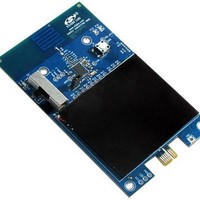ENERGY-HARVEST-RD Silicon Laboratories Inc, ENERGY-HARVEST-RD Datasheet - Page 4

ENERGY-HARVEST-RD
Manufacturer Part Number
ENERGY-HARVEST-RD
Description
RD ENERGY HARVESTING
Manufacturer
Silicon Laboratories Inc
Type
Energy Harvestingr
Datasheet
1.ENERGY-HARVEST-RD.pdf
(12 pages)
Specifications of ENERGY-HARVEST-RD
Output Voltage
4.1 V
Interface Type
USB
Output Current
50 nA
Product
Power Management Development Tools
Lead Free Status / RoHS Status
Lead free / RoHS Compliant
For Use With/related Products
Si1012
Other names
336-2047
Available stocks
Company
Part Number
Manufacturer
Quantity
Price
Company:
Part Number:
ENERGY-HARVEST-RD
Manufacturer:
SiliconL
Quantity:
13
AN588
6. On the Sensor Node, press the button. This will wake the MCU from sleep mode. The first time the button is
7. After successful association, and upon each subsequent button press, the Sensor Node will transmit the battery
8. The Energy Harvesting Application will designate the first Sensor Node to associate as Node 1. Up to 4 nodes
9. In the Logic tab, the number of connected nodes is displayed and the RSSI (receive signal strength indicator) is
4
pressed the Sensor Node will attempt to associate with the EZRadioPRO USB Dongle. A short green or red
blink will indicate whether or not association was successful.
level and temperature data from the on-chip temperature sensor. It will also wake up once a second for 3
minutes to transmit the light level, as measured at the solar cell. After 3 minutes, the Sensor Node will go into
ultra-low power sleep mode until the next button press. The Sensor Node will blink green each time it wakes up
and transmits data if the system charge is higher than 75%. The Sensor Node may blink red if it does not
receive an acknowledgement from the USB Dongle. The USB Dongle will blink green each time it successfully
receives a valid packet.
are allowed to associate. Cover the solar cell, or shine a flashlight into it to see it dynamically update the light
level in the application. Pressing the button will update the temperature and battery level, and will also add one
extra minute before the sensor board goes into an ultra-low power sleep mode.
displayed for each node board. If you move the transmitting node board away from the dongle, the receive
signal strength should decrease. The approximate range is 100–300 feet for a fully charged system. If the
energy in the node board drops below 75%, the transmit power is reduced in order to preserve the remaining
charge. In this reduced power mode, the green LED will not blink on successful transmission, however the red
LED will still blink if a transmitted packet is not acknowledged by the dongle.
Figure 5. Energy Harvesting Demo with one Sensor Node
Rev. 0.2















